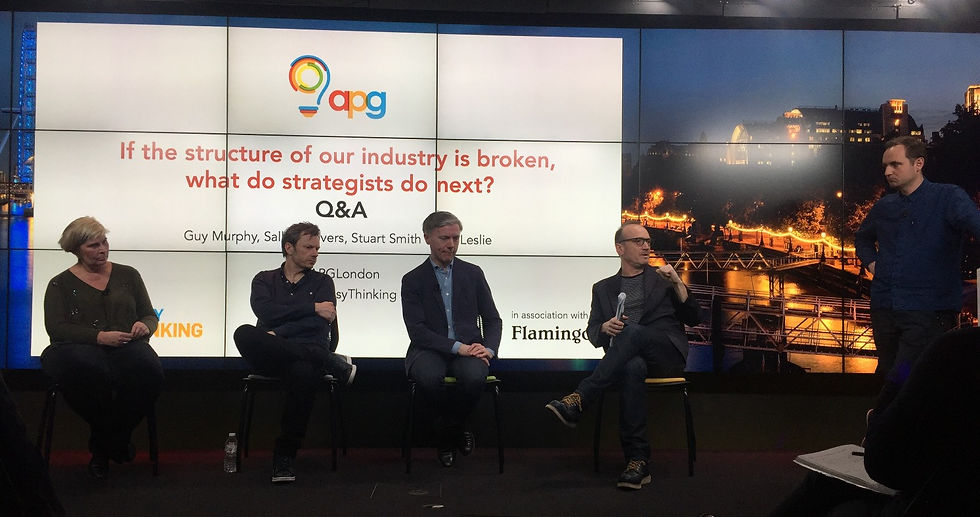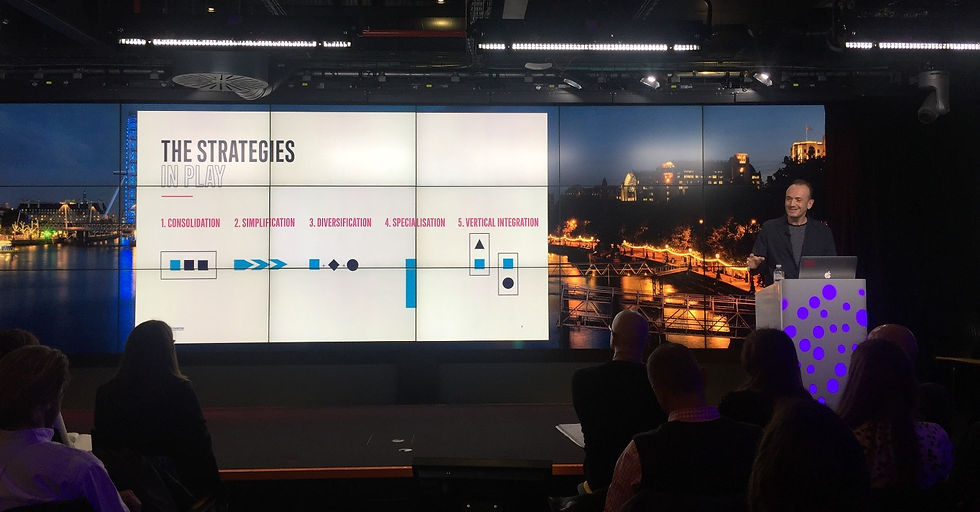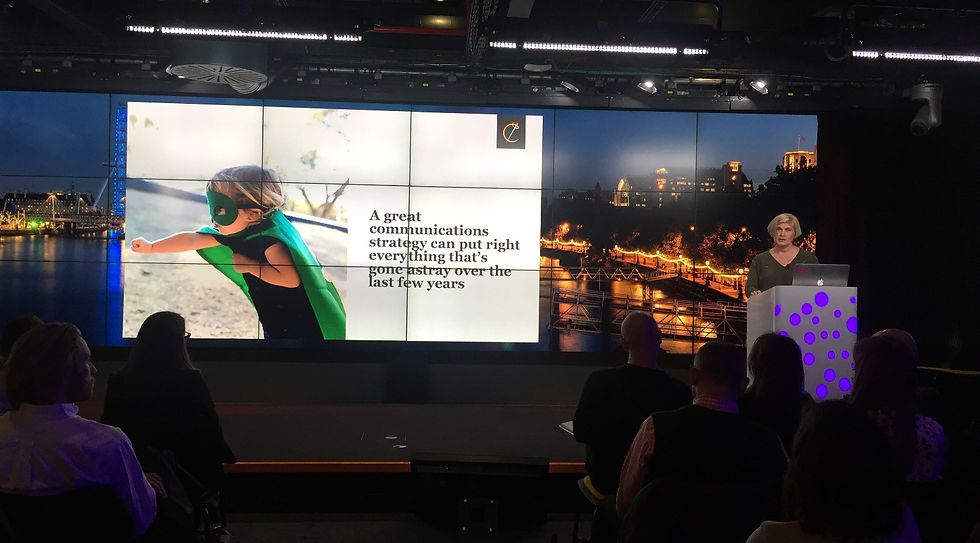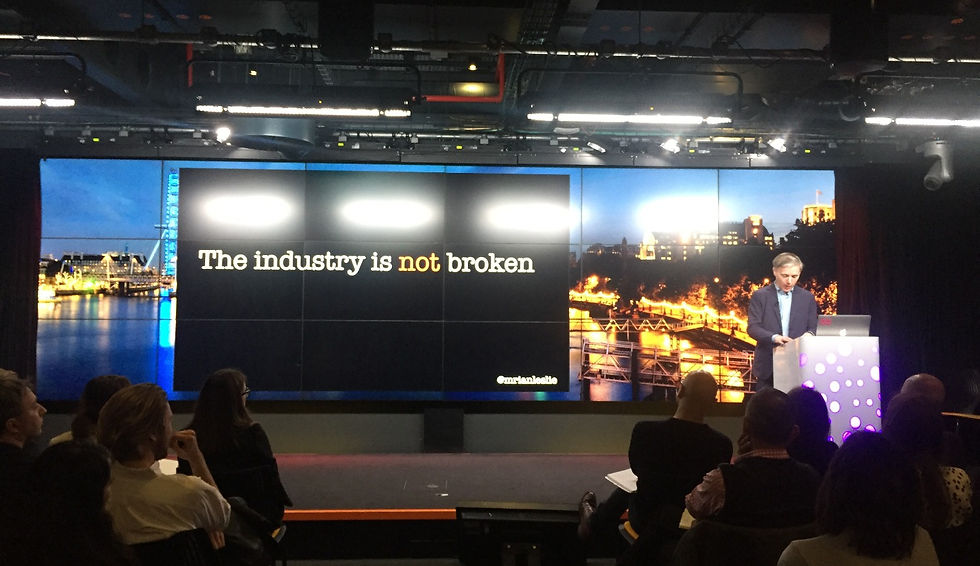APG Noisy Thinking | If the structure of our industry is broken, what should strategists do next?
- APG

- Mar 15, 2018
- 7 min read

This was a great big question designed to make us think about the big picture in a more strategic way, as well as offering some solutions and ideas for planners caught in the middle of change and wondering what if anything they can do about it. So we deliberately asked for contrasting views on what’s going on from the big agency/holding company POV, the reformed media strategist perspective, the strategist whose agency set out to challenge the prevailing model and the planner turned writer….
First was the network agency/holding company view from Guy Murphy who came straight in with a big strategic (not to say philosophical) perspective. He posited 3 possible answers to the question, what should strategists do?
Help fix the industry.
Leave.
Don’t leave and don’t help fix it.
He thinks option 3 is the prevailing behaviour; seeing it as other peoples’ problem. The ‘industry’ is not an amorphous thing but the sum of what we all do – all our actions and decisions. It’s just us doing our day jobs. So the remainder of his speech was aimed at those who do want to help.
What exactly is broken, then? Everyone likes to write about challenged industries but there is little commonality about the prescription to fix the problem, let alone the definition of that problem. Guy doesn’t think there is a ‘right answer’ and that may not be the point as clever people often don’t agree.
But clients are increasingly critical and Marc Pritchard’s recent coruscating speech is a case in point. P&G are talking agency services in-house and we re not going to continue to be paid unless we can do things better than our clients. We have lost control of the narrative of our business. Agency group share prices are all down since last year. Are these changes cyclical or structural?
What can we do to fix them?
According to Guy there are 5 strategies currently being employed:

Consolidation: The best talent pulled into leaner, faster teams. WPP style
Simplification: Removing complexity (structural/financial) and streamlining for clients. Publicis 1 style.
Diversification: Adding new capabilities, accessing new budgets; creating ‘end to end’ solutions for clients.
Specialisation: Doing one thing really well like data analytics or ethical programmatic platforms.
Vertical Integration: Moving up or down supply chains; business consultancy or vertical integration into media owners like Havas being bought by Vivendi.
What do you think? Which is the answer?
In a show of hands on the night, specialisation won.
There is nothing like a bit of audience participation to model the required behavior and Guy used it it to challenge us to get involved in the question – and plea for us to stay in the industry and fix it by thinking carefully about how we spend our day and how we go about doing our work.
So what should strategists do?
Never work in the same way twice.
Find people in your agency of a similar mindset and hook up with them
Don’t ask permission to do things or change things– it’s a creative business
Encourage and try new things
And when you’ve done all you can; leave.
Sally Weavers has come from the world of big media and big agencies and was unequivocal in her criticism of the way the way the media industry is structured and behaves, and the use and abuse of strategists in that world.

Before setting up Craft Media she spent 4 months doing interviews with clients and strategists to understand what needs to change, including endless pitching, overstretched top people, not enough contact with agency planners and more.
Sally is unsurprisingly messianic about the potential impact of a really good comms strategy to to solve world problems through the application of logical thinking, anticipation of hurdles and working out precisely what behaviour needs to change.
But how did we get here?
According to Sally:
We allowed a universal approach to problem solving and systematic output to take over from human insight.
We allowed 0% commission on new business wins.
We let programmatic take over.
We allowed the idea of the immediate ROI to prevail and we put too much money in too few channels – Google and Facebook.
What should we do about it?
It’s the job of really good (media) strategists to get brands noticed by taking big, strategic leaps and thinking about the intersection of brand/media/consumer.
Understand people, not audiences.
Make strategy valued and paid for and don’t allow time sheets where there is £0 against the names of the best thinkers.
Get project based and valued for your output, not for the sake of the retainer.
Lose egos and bullshit.
Go for crafted collaboration between media and creative strategists.
Bring back the art.
(and the heart?)
It struck me that Sally’s saying it’s time to turn the clock back 25 years. But is that possible?
Stuart Smith is an exceptional thinker but we invited him to talk to us as a partner at Anomaly, itself set up in reaction to a changing industry.
And to be fair we asked him to talk about how they work, so what follows is just that, rather than a puff for the agency….
He pointed out the ways of working that Anomlay uses to differentiate itself in the market place.
1. No Timesheets
There is no time charge, instead a ‘value based fee’. The prevailing philosophy is to put profit at risk against success because performance based revenue brings out more more exciting behaviour and and makes you accountable for the effectiveness of what you do.
2. Business Questions
Ask the right questions of the client up-front, interrogate the problem and re-frame the business challenge accordingly.
3. Open Creativity
This open approach precludes a bias to one channel or solution, means you have to be culturally more collaborative and more biased to what you think is right. This leaves it open for the ‘solution’ to be a partnership rather than a campaign for example. (It only works if your ECD is not driven by ego).

4. Create your own IP
They don’t do too much of this but they do enough that they understand viscerally what it means to create product. They have had a big success with medical marijuana in the US.
5. Global P&L
One bottom line makes you flexible and means you can move people around.
So what’s the advice for strategists from all this?
Work somewhere open. You don’t have to change agency but seek out genuinely collaborative relationships that make you think broadly.
Delay the brief. Resist pressure to get it straight into the creative department and where possible get everyone round a table to talk about the shape of the answer in the broadest terms before even thinking about writing a specific brief.
Create comms models. Try and own the model. Value the media bit highly. Put it up front in the pitch so that the client understands the ‘go to market’ approach and add on the creative idea by showing how the thinking will play out.
Start at the end. In a programmatic world. Revers the AIDA model (c.1904…)
Don’t work 5 days. If only, I hear you sigh. Maybe agencies would get far more out of everyone if they gave them a lot more flexibility about their lives.
Ian Leslie was on last because I had a hunch that he would have a rather different approach to the brief. He was all about why you should write. In Ian’s view the industry’s not broken; but that’s no reason not to develop a side-hustle like writing for Netflix which is about to invest $8 billion in 700 new shows and a real incentive for all of us to think about creating content for ourselves.
Money aside, there are other advantages to writing…. And here are some reflections on the value of writing and how you could approach it.
Writing makes you smarter. It’s a form of thinking, that makes things clearer. As Joan Didion memorably expressed it: ‘I write to find out what I am thinking’
The process is the magic. There is no such thing as a creative idea without an execution; they are woven together. As Steve Jobs said, the disease of creative companies (and Apple sans Steve) is thinking that great idea is 90% of the work. Actually it’s all about getting the details right. Writing helps you do that.
Stop worrying about being original and just be you. If you’ve had an idea don’t worry about it if someone else seems already to have written it; when it is filtered through you it will become something original.

Let the idea lead you. Planners often think too logically about he creative process. Allow yourself to work around a cool, sexy image and create post rationalisations if necessary. Ian contended that the ‘Catcher in the Rye’ image in the middle of the book is pretty lame or incidental because JD Salinger simply fell in love with the phrase and built a book on it because he decided to make it work.
Trust yourself, just not right now. This was deep and rather helpful stuff for writing and for life…Ian urged us to distinguish between the ‘’noise’ and ‘signal’. It’s often hard when you are in the middle of something, to tell whether it’s good. If you’re lacking confidence in its worth, give it time. There is a distinction between the ‘emotional climate’ and the emotional weather. Don’t get done in by the weather in the short term if the climate is generally benign….
And where do we end up after all this analysis and advice?
My own view is that there are systemic and structural problems with the industry, as our speakers said; specifically with respect to remuneration and media agency practices, the apparent downgrading of imagination and creativity and the relentless pressure to perform fast over performing well.
But on the other hand there has never been a better time to be a strategist. Our population is growing fast because we are so much in demand. We can ply our trade across clients and different kinds of agency and create careers that are diverse and interesting as never before. I think the demand for creative thinking (with equal weight on both of those words) will actually increase in proportion to the stranglehold of programmatic and AI; and the need for sensitive human insight goes hand in hand with that.
We do have to keep our eyes open however and remember that we are the agents of our own destiny. Things do change quickly and you don’t want to get stuck in a moribund sweatshop where no-one really looks beyond the money. But if you’re clever, skilful and thoughtful, and like to exercise your imagination in the service of building brands and businesses, the world looks a bit like your oyster.
And if you need help with any of that, it’s what the APG is for.
Sarah Newman




Comments